If you’re in the San Jose area and would like to see a wildlife rehabilitation center, the Toucan Rescue Ranch is a great option. We recently visited and it was one of the best wildlife center tours we’ve done in Costa Rica. We did the sanctuary tour and sloth tour. In this post, we’ll give some background on the Toucan Rescue Ranch organization and what to expect on a visit.

Location
The Toucan Rescue Ranch is located in the mountains just north of San Jose in a small town called San Isidro de Heredia. It is about a 30-minute drive from downtown San Jose. Heredia is the closest major city.
How Toucan Rescue Ranch Started
Toucan Rescue Ranch was founded by Leslie Howle. Leslie’s background is that she lived in Costa Rica for part of her childhood, later moved, and then came back to Costa Rica in her 40s.
Upon her return, she started the Toucan Rescue Ranch with the aim of helping to rehabilitate toucans that had been injured in the wild or kept as pets. Hence the name, Toucan Rescue Ranch.
Costa Rica’s environmental agency (MINAE) recognized their success with toucans and soon started bringing them different types of birds.
Seeing that other animals needed help too, especially sloths, the organization expanded once again in 2007. Now, the Toucan Rescue Ranch helps all types of birds and mammals in Costa Rica out of their facility near Heredia.

They also have a property in the lush jungle of Puerto Viejo de Sarapiqui on the Caribbean slope. This is where the sloths finish their rehabilitation program and are released.
Tour
After a short drive from Heredia, we arrived at the entrance for the Toucan Rescue Ranch. It was cooler and misty, common weather for this mountainous area.
We passed through the large wooden gate and met some volunteers and staff. They directed us to the visitors center. Here, we met Joselyn, a tropical biologist. She would be our guide for the day.

Sloth Tour
Background
Jocelyn started with some background on the Toucan Rescue Ranch. We learned the rules for the tour as well: no touching the animals, no using a flash for photos, and no taking selfies. These measures all help to protect the wildlife.
Jocelyn then told us that we would be starting our day with the sloth tour and doing the sanctuary after.
Since sloths are a big part of the organization, we learned some details about the center’s sloth program.
Sloth School, as they call it, starts with preschool. This is where baby sloths who have been separated from their mother begin when they first arrive at the facility. They then go on to elementary school to learn to eat solids and climb. Middle school is next, followed by high school, where they’re in the “classroom” (an outdoor enclosure). Finally, the sloths go to university, an enclosure in the rainforest that lets them acclimate to being in the wild. Once ready, they are released.
Soon we got to meet Helga, the two-toed sloth we would be spending the next half-hour or so with.
Helga the Sloth
A vet brought out Helga in a large plastic container. Being careful not to handle her too much, the vet helped her onto some tree branches in the space next to us. This area was completely open to the elements and had a large tree and some extra branches that made a climbing structure.
Helga quickly began exploring, using her strong legs and claws to grasp onto the branches. We watched her sniff the air, heading toward a hibiscus flower that the staff had left. Grabbing it, she quickly devoured the pink petals. Jocelyn explained that sloths have a good sense of smell, but poor vision, which is why she was sniffing around.
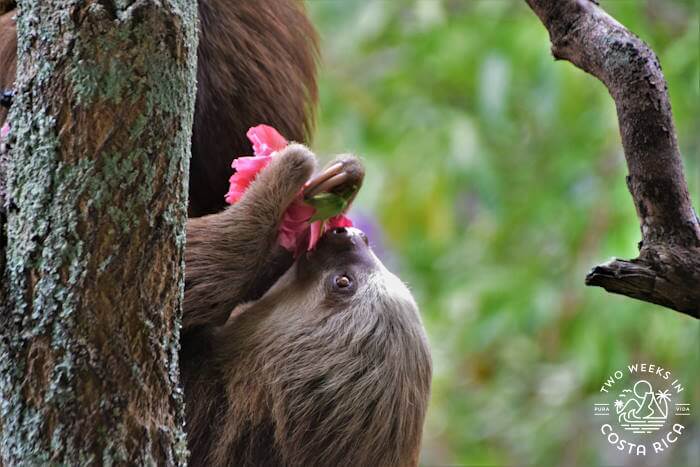
The sloth was only 10 feet or so away and without a barrier between us, we could get a good look at her.
Jocelyn explained that the story behind Helga was that she was living in a town park. When she was around two years old, the tree she was in was cut down without them realizing she was in it.
She arrived at Toucan Rescue Ranch and started the sloth program. Helga made it all the way through university but then didn’t want to get off the ground (sloths need to live in trees for safety) so couldn’t be released. She will now live the rest of her life in the sanctuary.
Wildlife Sanctuary Tour
Background
After some coffee and a snack, we started the wildlife sanctuary tour.
Toucan Rescue Ranch has a wildlife rehabilitation center where their veterinarians and staff care for animals that have been brought in. This area is closed off to visitors as they do not want the wildlife to get used to people. They release after rehabilitation whenever possible.
Visitors get to check out the sanctuary, which is where animals go when they cannot be released back into the wild.
Jocelyn took us around the short path to see the different enclosures and learn each animal’s story.
Sloths
We started by meeting some more two-toed sloths. First, we saw Georgia, the oldest animal at the sanctuary. She came to Toucan Rescue Ranch when she was a baby and is now 12 years old.
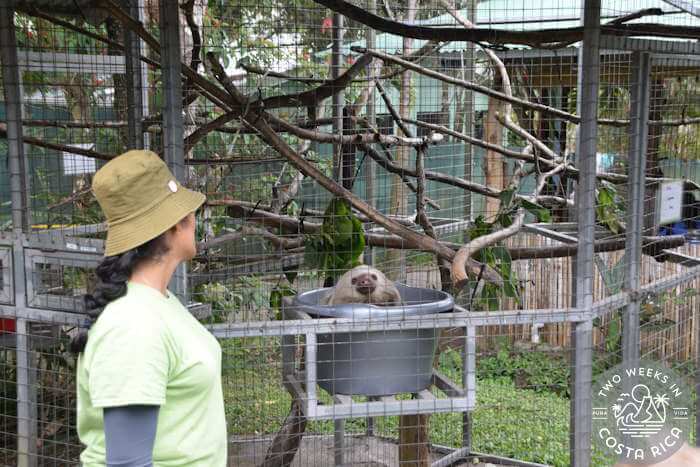
Stevie, another two-toed sloth, ended up at the sanctuary when she dropped out of university and wouldn’t feed herself. Latte, the sloth, had the same problem.
Oncilla
Next, we met Taboo, an oncilla. This small spotted cat was kept in a house in Coronado. He was fed by humans and raised as a domestic cat. Taboo still needs a litter box today to go to the bathroom.
Birds
They also had a lot of birds of prey.
Roadkill, a roadside hawk, came from a city after being hit by a car when hunting. He lost a wing so can’t fly anymore.
Night Wing and Batman were Bat Falcons. They were also hit by cars when hunting bats at night.
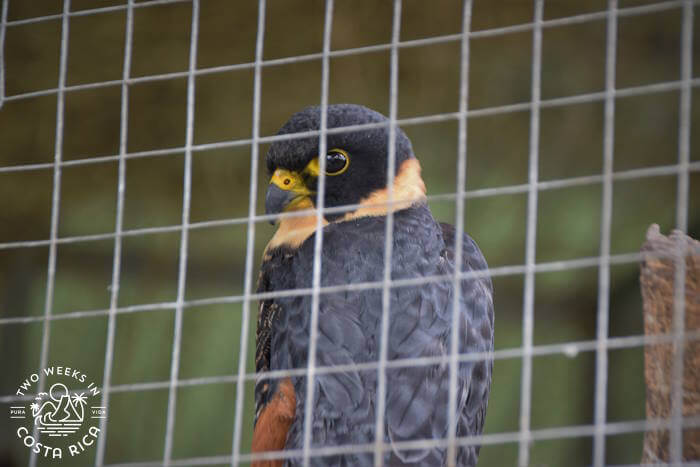
Kirk, a Crested Caracara, the biggest type of falcon in Costa Rica, didn’t perform well during a flying test so couldn’t be released.
We also got to see two Spectacled Owls, the largest owl in Costa Rica, and several Scarlet and Great Green Macaws. The Scarlet Macaws were confiscated after being pets.

Felicia, the ocelot, was another big cat that was kept as a pet inside a small room of a house for nine years. She didn’t get any light so her fur got really pale.
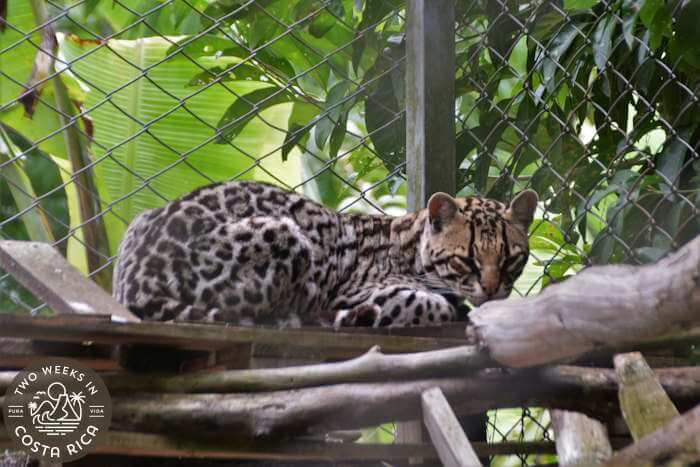
The center had several toucans, aracaris (relatives of toucans), and green parrots as well. Some of them had been injured and some kept as pets.

Monkeys
The story of Samba the spider monkey was particularly compelling.
Samba had been kept as pet. A little girl who lived nearby saw the monkey and asked her parents about it. Her parents said it was nothing to worry about. She learned at school, though, that it is illegal to have wild animals as pets in Costa Rica. So the little girl brought the monkey into the police herself!
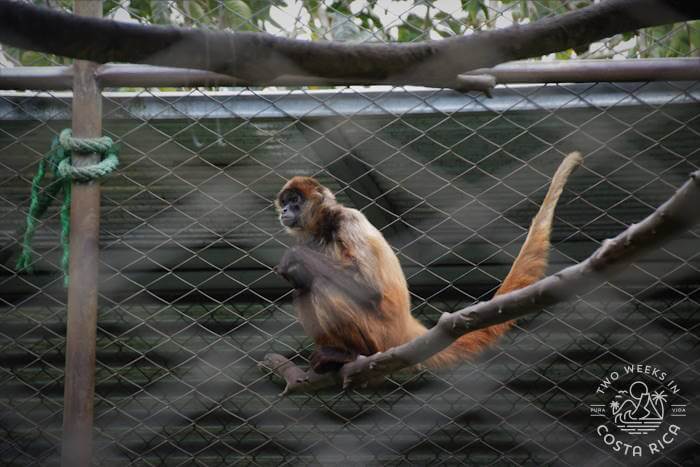
One of our kids’ favorite animals was the tropical river otter. The center got him as a baby. Some kids were throwing rocks at him and his mother. His mother got scared off and didn’t come back. Joselyn told our kids that the otter liked to play a game where you run alongside the tank, and he would follow. Sure enough, the otter loved this enrichment activity and so did our two boys.
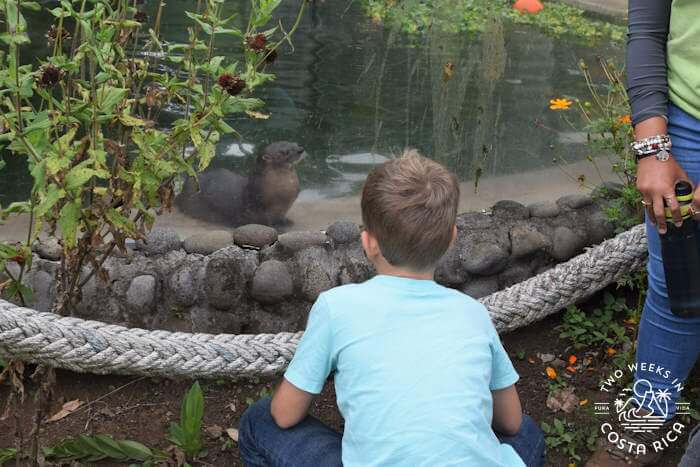
For each animal, Jocelyn told us not only how it got to the facility but also interesting facts about the species.
Supporting Toucan Rescue Ranch
We have done many wildlife center tours in Costa Rica, and this was one of the best. Our guide was extremely knowledgeable and passionate about her job. From walking the grounds and interacting with the team that works there, it is clear that Toucan Rescue Ranch is a well-run organization.
Their sloth tour is particularly special as it allows you to see a sloth close up, without a fence in between. The staff at Toucan Rescue Ranch limits their interaction with the animal and has rules that prevent people from getting too close.
You can find other sloth tours in Costa Rica but be aware that some of them are illegal. We have heard of people taking sloths from the wild and bringing them to their private nature reserve just so that it’s easier for people to see them.
When booking a sloth tour, be sure that the tour operator is reputable. A good clue that something isn’t right is if the tour guarantees you’ll see a sloth in the wild. Aside from a wildlife rescue center, it is difficult to guarantee a sloth sighting. Sloths are very territorial and are often hiding high in the rainforest canopy.
Adopting an Animal and Amazon Wish List
You can support the work of Toucan Rescue Ranch just by doing a tour. You also can donate (Toucan Rescue Ranch is a U.S. 501(c)(3) non-profit) or symbolically adopt an animal.
Another way to help is to bring something from their Amazon Wish List that is hard to get in Costa Rica. Here’s the link.
Visiting the Toucan Rescue Ranch
Advanced reservations are required. Tickets can be purchased directly through their website.
Sanctuary Tour (Classic Ranch Walk)
2 hours
$37/adult, $19/seniors age 65+, $19/children ages 6-10
Sloth & Coffee Tour (Includes Classic Ranch Walk)
2.5 hours
$62/adult, $32/seniors age 65+, $32/children ages 6-10
Accessibility
Toucan Rescue Ranch is handicap accessible. The sanctuary path is very short and flat.
Conclusion
Our family really enjoyed our visit to the Toucan Rescue Ranch. Getting to see Helga the sloth so close, going about her day, was really special. Our kids also loved being able to see the other animals in their enclosures and learn the story behind each one.
Have a question about visiting the Toucan Rescue Ranch or have you been? Leave a comment below.
Looking for more information to plan your trip to Costa Rica? Check out these posts:
El Arca Botanical Garden & Restaurant: Another great day trip from San Jose is this botanical garden and farm-to-table restaurant.
Kids Saving the Rainforest: If you’re visiting the Manuel Antonio area, Kids Saving the Rainforest is another wonderful wildlife center to check out.
A Classic Costa Rican Coffee Tour at Cafe Britt – Café Britt is one of Costa Rica’s largest coffee producers. Learn more about the growing and production process on a visit.
